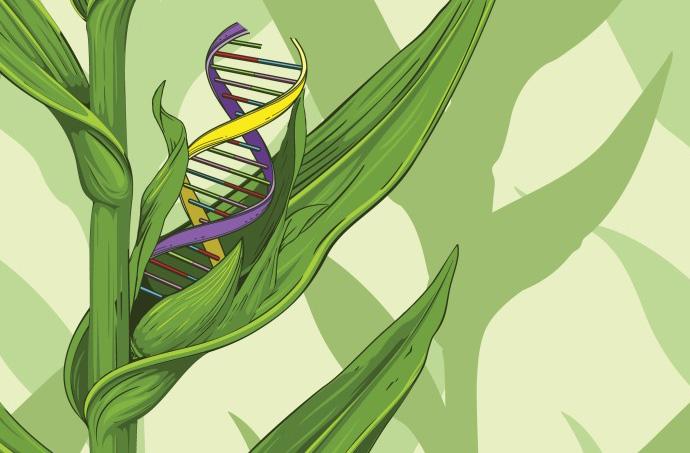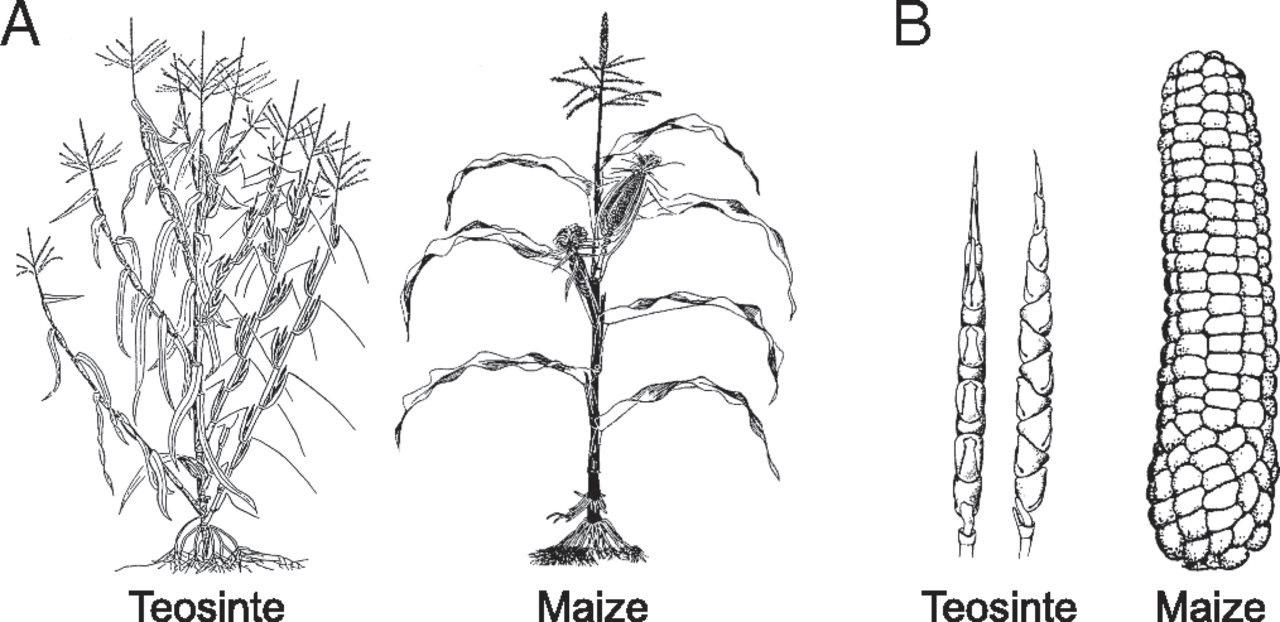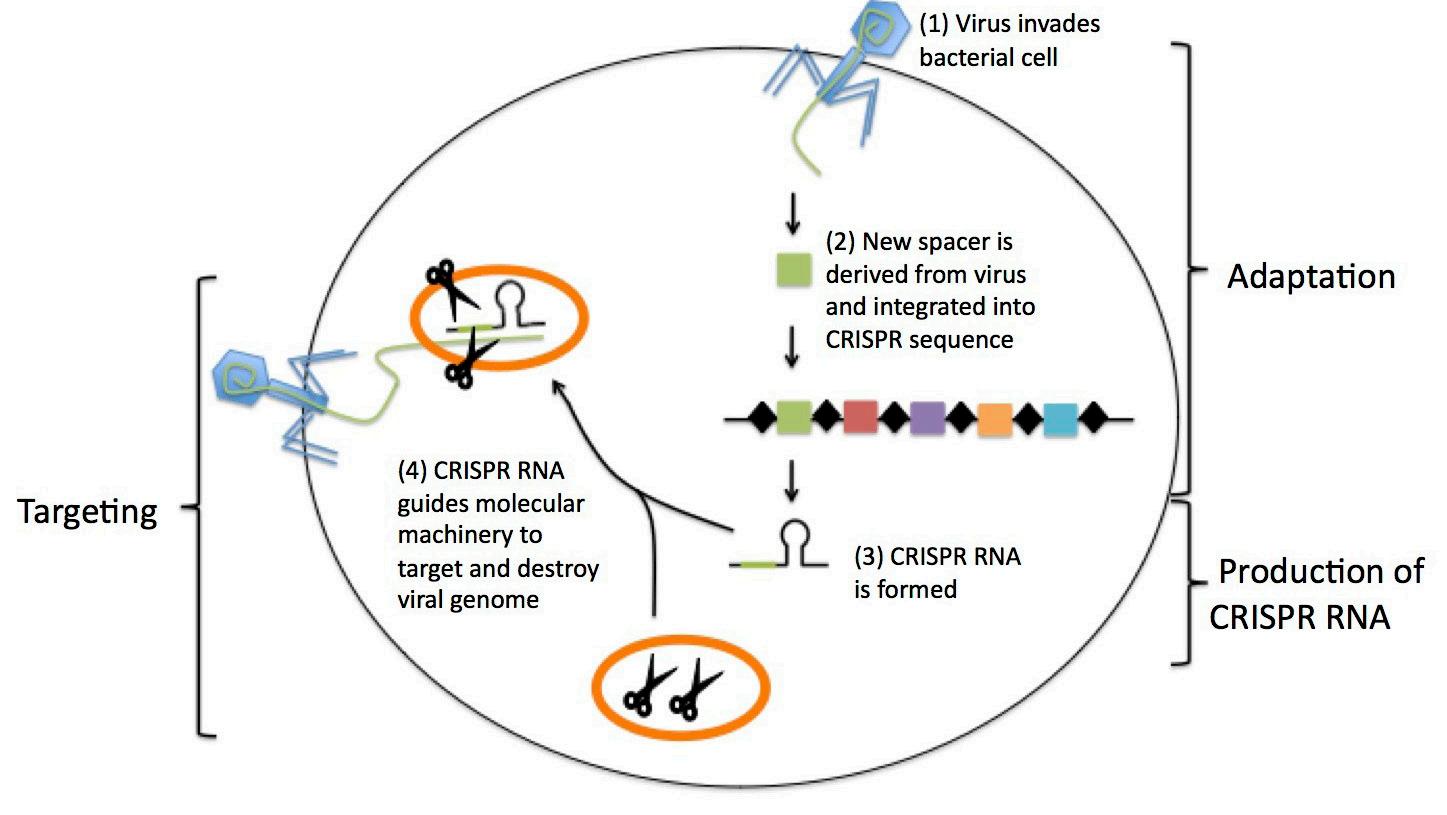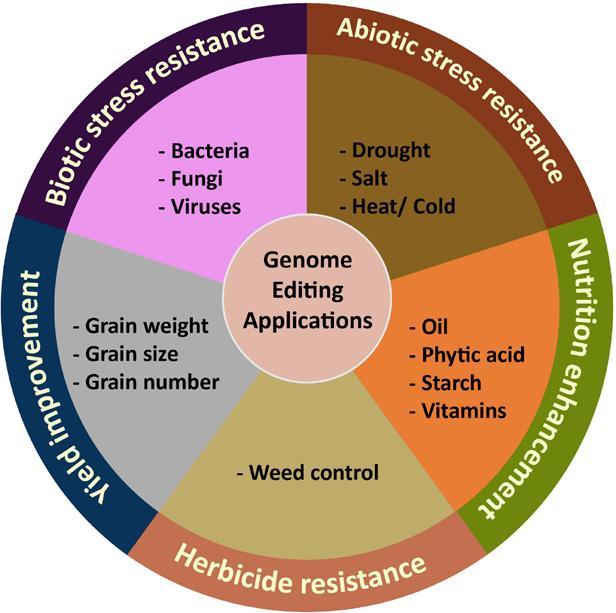
10 minute read
CRISPR Crops: The Future of Agriculture Emily Pearlman
CRISPR CROPS: THE FUTURE OF AGRICULTURE BY EMILY PEARLMAN
Corn: the crop America knows and loves… or so we think. Modern corn looks so different from its original form, a wild grass called teosinte, that you would be hard-pressed to recognize the two are related. Over thousands of years of directed evolution, teosinte’s tiny ears and indigestible kernels morphed into maize’s large ears, each with as many as 500 juicy kernels (Fig. 1). 1 Corn is just one example of human-directed evolution of plants; we have been domesticating and cultivating crop species since the beginning of civilization. Although the technology used to selectively breed plants has grown more advanced over time, the basic principle remains the same—harnessing existing variation in a species to increase the prevalence of traits we consider “desirable,” such as larger ears on corn. Historically, this was achieved by successive rounds of breeding; today, with powerful genome editing tools at our fingertips, we have the ability to attain the same (and more drastic) results with less time and effort.
Advertisement

Figure 1: Thousands of years of selection for traits amenable to human
consumption has resulted in the evolution of teosinte into maize. Now, with genome editing, we can accomplish the same changes in a much shorter time.
The power of genome editing is unprecedented. Never before have we been able to direct evolution in the blink of an eye. What once would have taken years of selective breeding can now be accomplished in a lab in a matter of months. This is not only possible, but also becoming necessary—with a growing human population and increasingly challenging environmental conditions, the use of genome editing to augment agricultural production will be essential to feeding the world. Current research focuses on using CRISPR-Cas genome editing to enhance crop species by increasing yields and bolstering resistance to abiotic (e.g., drought) and biotic (e.g., bacterial and viral pathogens) stresses. 2
WHAT IS CRISPR-CAS?
CRISPR has received a lot of attention in the scientific world lately for its applications in genome editing, but it has actually been around for millions of years as a bacterial immune system. Just as we have an immune system that defends us against the viruses and bacteria that make us sick, some bacteria have immune systems of their own that protect them against viruses called bacteriophages. As the name suggests, CRISPR-Cas consists of two components: clustered regularly interspaced short palindromic repeats (CRISPR), and Cas, a DNA-cutting enzyme. You can think of CRISPR as “molecular memory” and Cas as “molecular scissors.” When a bacteriophage infects a bacterium, the bacterium can steal sections of the phage’s genetic information and store them within its own genome, filing them away in a library of other phage-derived sequences. By retaining phages’ genetic information, bacteria can essentially “remember” phages and mount more efficient attacks against them during future encounters, using their Cas enzyme to cut the phage’s genome and prevent infection (Fig. 2). 3

The power of Cas enzymes lies in their sequence specificity; this means that they can be directed to cut specific DNA sequences. This makes them the perfect tool for targeted genome editing. Researchers can program Cas9, a commonly used Cas enzyme, to target a particular gene and create a break in the DNA, which the cell will subsequently repair via one of its natural DNA repair pathways. One option for the cell is to directly attach the two ends of the break, creating large mutations which often result in a loss of function of the gene, effectively “knocking out” the gene. If researchers provide the cell with a piece of DNA, however, the cell will repair the break using this piece of DNA as a template. Knocking out a gene can be helpful when trying to determine its function, while using a repair template allows researchers to make specific edits to a gene. 3 INCREASING DROUGHT TOLERANCE IN MAIZE
Drought causes substantial agricultural losses each year and is only expected to worsen with warming global temperatures, so one major focus of current research is increasing crop yield under drought conditions. 4 Jinrui Shi and his colleagues at DuPont, Inc., used CRISPR-Cas9 to do just this. By replacing the regulatory elements of a drought resistance gene with those of another gene that is expressed at much higher levels, they increased the overall expression of the drought resistance gene. When Shi and his team grew the genome-edited plants alongside non-edited plants in drought stress locations, they found that their experiment was a success—the edited plants produced significantly more bushels per acre, showing that targeted genome editing is effective in increasing maize yield under drought conditions. Although this result had been achieved by introducing foreign DNA into plants through a process called transgenesis, Shi’s CRISPR-edited maize plants con-
Figure 2: CRISPR is a type of bacterial im
mune system. When a bacterium encounters a virus, it can steal part of the virus’s genome and store it in a CRISPR sequence. If it encounters the same virus again, the bacterium can use this stored information to target and
destroy the viral genome. tained no non-maize DNA. Furthermore, all of the genes used for editing (e.g., Cas gene) were removed through backcrossing, leaving no trace of the team’s work in the genome. 5 This distinction explains the disparity in regulation of CRISPR-edited plants and classical transgenic GMOs—CRISPR-edited plants contain no foreign DNA, they pose fewer safety concerns, and aren’t regulated as strictly. 2
BOLSTERING VIRAL RESISTANCE IN CASSAVA
Viral diseases also pose a major threat to crop yields worldwide. Cassava, the fourth most important staple crop worldwide (after rice, maize, and wheat), 6 is threatened by Cassava brown streak disease (CBSD), caused by Cassava brown streak virus (CBSV). CBSD, which renders the cassava root inedible, poses a major threat to food and economic security in East Africa, causing losses of $175 million every year. 6
Brian Staskawicz, Professor of Plant and Microbial Biology at UC Berkeley, used CRISPR-Cas9 to increase CBSD resistance in cassava by selectively mutating multiple genes. These genes encode receptors that the CBSV viral proteins must interact with in order to successfully enter the cassava cell. Staskawicz’s team used CRISPR-Cas9 to create a range of knockout mutations in the receptor genes, effectively preventing them from being expressed. When the genome-edited plants were inoculated with CBSV and grown in a greenhouse, they displayed reduced CBSD symptoms: their roots were significantly less rotted and contained less virus than the roots of control plants. 7 Developments like this demonstrate the potential of CRISPR-Cas to effectively engineer pathogen resistance in major crop species and avert sizable losses in yields.
CONCLUSION
Although CRISPR-Cas is a powerful genome editing tool, some obstacles to its widespread implementation still remain. One limitation of genome editing is its reliance on sequence and functional genomic data; in order to alter a certain trait of a plant, it is necessary to know which genes are responsible for the trait, a determination which can be difficult. For instance, the drought response in plants is complex and relies on a multitude of genes,
Figure 3: Genome editing in crop species has many applications,
ranging from abiotic and biotic stress resistance to yield improvement and herbicide resistance.

not all of which are known. 8 But despite these drawbacks, genome editing remains a burgeoning field of research that will be essential to the future of agriculture. The studies outlined here represent a small subset of the research being conducted on CRISPR-Cas genome editing in crop species; this technology has been used to generate pest resistance in wheat, enhance herbicide resistance in tobacco, and increase yield in rice, among many other traits (Fig. 3). 2, 8 Exciting new research is using CRISPR to explore the complex symbiotic relationship between legumes and their rhizobia, with the goal of recreating this relationship in other crops and reducing our dependence on harmful chemical fertilizers. 9
Since the beginning of civilization, humans have been transforming plants to suit our needs. Genome editing is merely the latest chapter. Climate change has already had a major and multifaceted impact on agricultural productivity, and its effects are only expected to worsen. 10,11 Additionally, the human population is expected to increase to nearly 10 billion by 2050, placing further pressure on us to dramatically increase agricultural productivity. 12 In the face of a rapidly growing human population and increasingly difficult environmental conditions, the use of genome editing tools such as CRISPR-Cas to enhance crop species will be vital to feeding the world.
REFERENCES
Doebley, J. (2004). The genetics of maize evolution. Annual Review of Genetics, 38(1), 37–59. https://doi.org/10.1146/annurev. genet.38.072902.092425 Sedeek, K. E. M., Mahas, A., & Mahfouz, M. (2019). Plant genome engineering for targeted improvement of crop traits. Frontiers in Plant Science, 10. https://doi.org/10.3389/fpls.2019.00114 Jinek, M., Chylinksi, K., Fonfara, I., Hauer, M., Doudna, J. A., & Charpentier, E. (2012). A programmable dual-RNA-guided DNA endonuclease in adaptive bacterial immunity. Science, 337(6096), 816–821. https://doi.org/10.1126/science.1225829 Food and Agriculture Organization of the United Nations. (2018, March). The impact of disasters and crises on agriculture and food security 2017. http://www.fao.org/resilience/resources/resourcesdetail/en/c/1106859/ Shi, J., Gao, H., Wang, H., Lafitte, H. R., Archibald, R. L., Yang, M., Hakimi, S. M., Mo, H., & Habben, J. D. (2017). ARGOS8 variants generated by CRISPR-Cas9 improve maize grain yield under field drought stress conditions. Plant Biotechnology Journal, 15(2), 207–216. https://doi.org/10.1111/pbi.12603 7.
8.
9.
10.
11.
12. 1. 2. 3. 4. Michael, W. (2013, February 13) African smallholder farmers need to become virus detectors. Inter Press Service. http://www.ipsnews. net/2013/02/african-smallholder-farmers-need-to-become-virusdetectors/ Gomez, M. A., Lin, Z. D., Moll, T., Chauhan, R. D., Hayden, L., Renninger, K., Beyene, G., Taylor, N. J., Carrington, J. C., Staskawicz, B. J., & Bart, R. S. (2019). Simultaneous CRISPR/Cas9- mediated editing of cassava eIF4E isoforms nCBP-1 and nCBP2 reduces cassava brown streak disease symptom severity and incidence. Plant Biotechnology Journal, 17(2), 421–434. https://doi. org/10.1111/pbi.12987 Scheben, A., Wolter, F., Batley, J., Puchta, H., & Edwards, D. (2017). Towards CRISPR/Cas crops—Bringing together genomics and genome editing. The New Phytologist, 216(3), 682–698. https://doi. org/10.1111/nph.14702 Wang, L., Wang, L., Zhou, Y., & Duanmu, D. (2017). Chapter Eleven—Use of CRISPR/Cas9 for symbiotic nitrogen fixation research in legumes. In D. P. Weeks & B. Yang (Eds.), Gene Editing in Plants (Vol. 149, pp. 187–213). Academic Press. https://doi. org/10.1016/bs.pmbts.2017.03.010 Tilman, D., Balzer, C., Hill, J., & Befort, B. J. (2011). Global food demand and the sustainable intensification of agriculture. Proceedings of the National Academy of Sciences, 108(50), 20260. https://doi.org/10.1073/pnas.1116437108 Zhao, C., Liu, B., Piao, S., Wang, X., Lobell, D. B., Huang, Y., Huang, M., Yao, Y., Bassu, S., Ciais, P., Durand, J.-L., Elliott, J., Ewert, F., Janssens, I. A., Li, T., Lin, E., Liu, Q., Martre, P., Müller, C., … Asseng, S. (2017). Temperature increase reduces global yields of major crops in four independent estimates. Proceedings of the National Academy of Sciences, 114(35), 9326–9331. https://doi. org/10.1073/pnas.1701762114 Department of Economic and Social Affairs. (2019). Total population (both sexes combined) by region, subregion and country, annually for 1950-2100 (thousands). (File POP/1-1) [Data set]. United Nations. https://population.un.org/wpp/Download/
Standard/Population/ IMAGE REFERENCES
Banner: Chemical & Engineering News. (2017, June 12). An illustration of a DNA double helix growing out of a corn plant in place of a cob [jpg image]. https://cen.acs.org/articles/95/i24/CRISPRnew-toolbox-better-crops.html Figure 1: Yang, C. J., Samayoa, L. F., Bradbury, B. J., Olukolu, B. A., Xue, E., York, A. M., Tuholski, M. R., Wang, E., Daskalska, L. L., Neumeyer, M. A., Sanchez-Gonzalez, J. d. J., Romay, M. C., Glaubitz, J. C., Sun, Q., Buckler, E. S., Holland, J. B., & John F. Doebley. (2019, March 19). The genetic architecture of teosinte catalyzed and constrained maize domestication. Proceedings of the National Academy of Sciences, 116(12), 5643–5652. https://doi.org/10.1073/ pnas.1820997116 Figure 2: Science in the News. (2014, July 31). The steps of CRISPR-mediated immunity [jpg image]. http://sitn.hms.harvard. edu/flash/2014/crispr-a-game-changing-genetic-engineeringtechnique/ Figure 3: see Reference #2.










